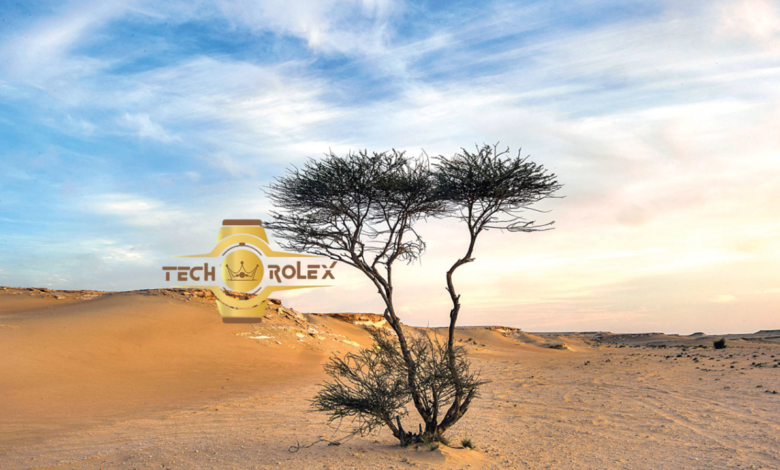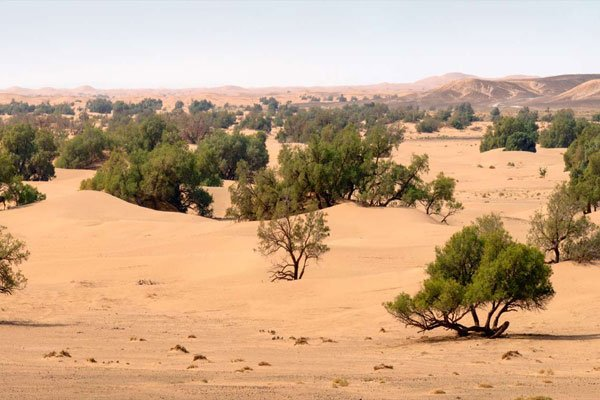Desert Trees: Cool Plants That Grow in Hot, Dry Places

Desert trees are some of nature’s toughest survivors. They grow in places where it’s hot, dry, and often windy. While most trees need a lot of water to stay alive, desert trees have learned to live with very little. These trees don’t just survive—they help people, animals, and the planet in many surprising ways.
What Are Desert Trees?
Desert trees are a special kind of tree that grow in very dry areas, also known as arid or semi-arid regions. These trees are built to handle extreme heat, dry winds, and little rainfall. You won’t find desert trees in places with cold winters or lots of rain. Instead, they grow in deserts like the Mojave, Sonoran, and Chihuahuan Deserts in the United States.
These trees have special features that help them live in harsh places. Some have deep roots that reach far underground to find water. Others store water in their trunks, branches, or leaves. Some desert trees have tiny leaves or even no leaves at all to keep from losing water. They grow slowly but live long lives.
Where Do Desert Trees Grow?
Desert trees mostly grow in the southwestern part of the United States. This includes states like Arizona, California, Nevada, New Mexico, and Texas. These areas have deserts with very little rain, hot summers, and mild winters.
But desert trees don’t only grow in open deserts. They also grow in dry riverbeds, rocky hills, and even people’s backyards. Many people in the U.S. now use desert trees in landscaping because they look beautiful and don’t need much water. Cities like Phoenix and Las Vegas use desert trees to bring shade and color without wasting water.
Why Are Desert Trees Important?
Desert trees are more than just survivors—they play a big role in keeping the desert healthy. They help the land, clean the air, give homes to animals, and even support people. Even though they grow in tough places, desert trees are a powerful part of the natural world.

Desert Trees Help the Soil
The roots of desert trees hold the soil together so it doesn’t blow away in the wind. In dry areas, soil can easily turn to dust and get carried away. But trees keep the ground in place. Their fallen leaves also help make the soil better by adding nutrients when they break down.
They Clean the Air
Just like other trees, desert trees take in carbon dioxide and release oxygen. This helps reduce pollution and cool down the air. Even though desert trees are small compared to forest trees, they still help clean the environment. In cities, planting desert trees can make the air fresher and improve health.
Animals Love Desert Trees
Desert trees provide food and shelter for many animals. Birds build nests in their branches. Insects live in their bark. Some animals eat their leaves, flowers, or seeds. Bees love the flowers of mesquite and palo verde trees. These trees are like little homes for desert wildlife.
Best Types of Desert Trees in the USA
There are many types of desert trees that grow across the United States. These trees are native to the desert and do well with little water. Some are famous for their beauty, while others are known for their usefulness.
Popular types of desert trees in the USA include:
- Mesquite trees – Known for their sweet pods and shady branches.
- Palo verde trees – Recognized by their green bark and yellow flowers.
- Joshua trees – Unique, spiky trees that are a symbol of the Mojave Desert.
- Ironwood trees – Very strong trees that support desert ecosystems.
- Desert willow trees – Known for their pink and purple flowers.
These trees are all drought-tolerant and perfect for hot climates.
Mesquite Tree — The Sweet Desert Tree
The mesquite tree is one of the most famous desert trees in the U.S. It grows in many dry areas, especially in Texas, Arizona, and New Mexico. The tree has long, spreading branches that give great shade. Its leaves are small and feathery, which helps reduce water loss.
What makes the mesquite tree special is its seed pods. These pods are sweet and can be ground into flour. Native American tribes used mesquite pods as food. Today, mesquite wood is used for grilling meat because it adds a smoky flavor.
Mesquite trees also help the soil. Their roots reach deep underground and bring nitrogen into the soil, which helps other plants grow. These trees are a great choice for landscaping in dry areas because they need very little water once established.
Palo Verde — The Green Stick Tree
Palo verde means “green stick” in Spanish, and it’s easy to see why this tree got its name. The tree’s bark is bright green because it contains chlorophyll. That means the tree can make food even when it loses its leaves during the hottest months.

Palo verde trees bloom in the spring with small yellow flowers. These flowers attract bees and butterflies. The tree grows quickly and can live for many years. It’s a favorite in desert cities for its beauty and toughness.
Grows in Arizona and California
You can find palo verde trees all over Arizona and parts of southern California. The tree does very well in places like Phoenix, Tucson, and Palm Springs. It grows in sandy and rocky soil, and it doesn’t mind the heat at all.
Used in Landscaping
Palo verde trees are often planted in parks, along roads, and in people’s yards. They add color and shade without using much water. There are several kinds of palo verde trees, like the blue palo verde and the foothill palo verde. Each one is a little different, but all are perfect for hot, dry places.
Joshua Tree — The Famous Spiky Tree
The Joshua tree is one of the most unusual-looking trees in the world. It only grows in the Mojave Desert, mostly in California, Nevada, Utah, and Arizona. The tree has thick branches and spiky leaves that look like swords.
Joshua trees are slow growers and can live for hundreds of years. They are part of the yucca plant family. Their white flowers bloom in spring and attract moths, which are the only insects that can pollinate them.
The Joshua tree is so famous that there’s even a national park named after it—Joshua Tree National Park. This park protects thousands of these amazing desert trees. The trees are important to Native American cultures and to the animals that live in the desert.
How Do Desert Trees Survive the Heat?
Desert trees have many smart ways to survive in hot and dry climates. First, they often grow very deep roots—sometimes 50 feet or more! These roots help the tree reach underground water. Some desert trees can go months without rain by storing water in their trunks or leaves.
Another trick is having tiny leaves or no leaves at all. This stops the tree from losing too much water. Trees like the palo verde can even do photosynthesis through their bark. Many desert trees grow slowly so they don’t need much energy or water. Their thick bark also protects them from the sun and dry winds.
Desert trees don’t just survive—they thrive. They’ve adapted over thousands of years to live in places where few other plants can grow. These trees are nature’s answer to extreme weather.
The Bottom Line
Desert trees are tough, beautiful, and important. They grow in some of the hottest, driest places in the world, including the deserts of the southwestern United States. Trees like the mesquite, palo verde, and Joshua tree show how plants can survive and even thrive in harsh conditions.
These trees help the environment in many ways. They stop soil from blowing away, clean the air, and give animals a place to live. People also love them because they don’t need much water and still offer beauty and shade.



